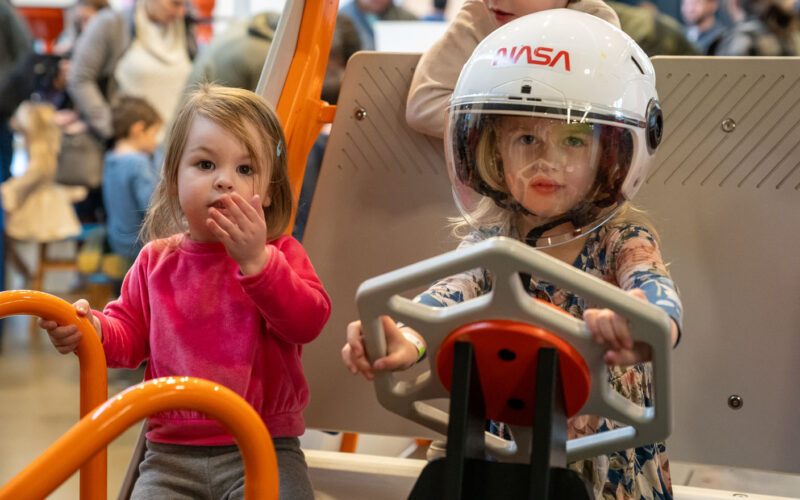MONICA HOOPER
mhooper@nwaonline.com
Calling all young astronauts!
Before your child pulls you to the Scott Family Amazeum’s pretend Neighborhood Market where they can grab everything, the “Moon to Mars” exhibit at the Bentonville children’s museum inspires little ones to shoot for the cardboard moon now and for the real Mars later.
Developed by the Omaha (Neb.) Children’s Museum in partnership with NASA’s Deep Space Exploration Systems at Johnson Space Center, the exhibit includes a station for kids to build their own paper rockets with simple instructions and materials at hand. Then kids (and parents) can take the rocket to a nearby launching station with air pumps that help the tiny navigators send their rocket out in space.
Nearby there’s a replica of a Lunar Rover that allows kids to climb aboard and pretend — just be mindful of the removable plates on the rover. Little ones enjoy playing with pulleys, funnels and small tunnels on the Artemis Base, another part of the exhibit that allows kids to climb on. Kids can put on space helmets and pilot the Orion Spacecraft in a semi-immersive exhibit showing life amidst celestial orbits.
“Moon To Mars” will be in the Amazeum’s Traveling Exhibits Gallery until May 6. Admission is free for members and included in the $12 admission for nonmembers. Hillary Horner, director of education, and Mark Jacobsen, director of exhibits, from the Omaha Children’s Museum answered a few questions about the exhibit for What’s Up!
How was NASA involved in creating the exhibit Moon to Mars?
During the design phase, we visited the Johnson Space Center to discover what the mission goals were for their latest program. We discussed the importance of diversity and that they wanted to feature some of the unique career paths into a job at NASA. Some examples are careers like clothing design and graphic arts. This information helped shape our vision for the exhibit.
Once the exhibit opened, we hosted a few livestream chats with NASA where our guests could ask questions. Additionally, NASA provides many educational programs accessible to classrooms and organization guests. We used many of those same resources to enhance the exhibit and our educational offerings.
What do children learn about the Orion Spacecraft and how did you develop this exhibit?
At the heart of the exhibit is a large-scale model inspired of the Orion Spacecraft that guests can play in. This was built using the information gleaned from NASA, including solar panels, video screens showing the spacecraft’s journey, and opportunities for creative play, allowing guests to imagine themselves as pilots of the Orion Spacecraft.
What do you think kids take away from launching their own rockets even if they don’t understand all the “why” involved in their construction?
One of the most popular elements of the “Moon to Mars” exhibit gives guests the opportunity to build and launch their own rocket designs. This area hones in on both creative and inquisitive styles of play. While we give guests a general model, they can add embellishments and make any adjustments they choose. After testing their rockets, they are encouraged to contemplate why they achieved the results they did and are invited to make changes before launching their designs again. The opportunity for free-form exploration encourages children to consider important questions that help build their understanding of the scientific method: they make hypotheses of what will work, test those hypotheses and analyze the results. It also provides the space to, and even encourages them to, fail in their attempts. Some of the best learning occurs when we fail. Learning through trial and error and modification in a safe environment creates one of the greatest opportunities for us to learn and grow.
Is there anything that you’d like to add about the “Moon to Mars” exhibit?
There was so much joy in the journey. Everyone involved in the design process at Omaha Children’s Museum had a wonderful time working on this collaborative effort, made even sweeter by knowing that “Moon to Mars” continues to bring joy and imagination to children. Who knows, maybe the next generation of the NASA team is experiencing “Moon to Mars” now?
—
FAQ
‘Moon To Mars’
WHAT — An immersive exhibition for aspiring astronauts, scientists, engineers, and space enthusiasts, including a chance to pilot the Orion Spacecraft amidst celestial orbits, steer a Lunar Rover across uncharted extraterrestrial landscapes, construct moon bases and experience reduced gravity walks.
WHEN — Hours are 1-5 p.m. Sunday; 10 a.m.-5 p.m. Monday; 10 a.m.-7:30 p.m. Wednesday; and 10 a.m.-5 p.m. Thursday-Saturday, until May 6
WHERE — Scott Family Amazeum in Bentonville
COST — $12
INFO — amazeum.org
FYI — Priceless Nights, from 4:30-7:30 Wednesdays, allow patrons to pay as they wish.



